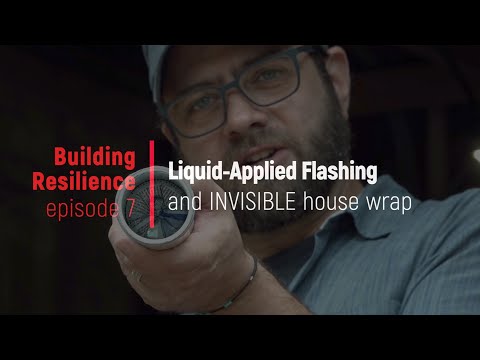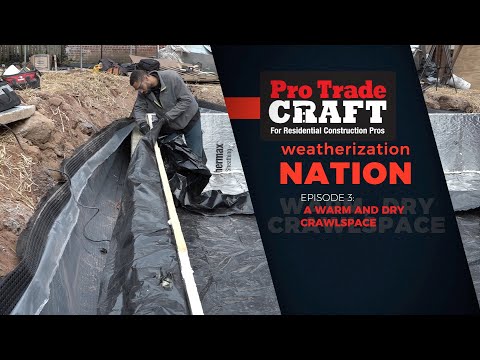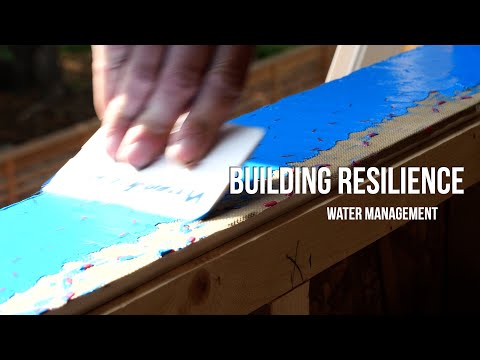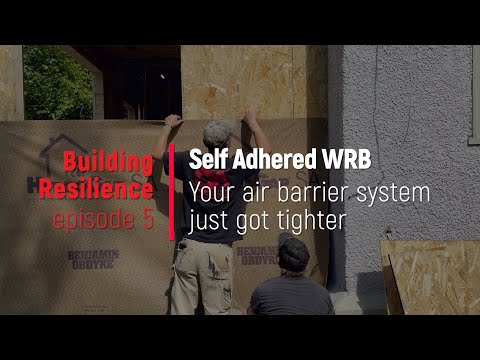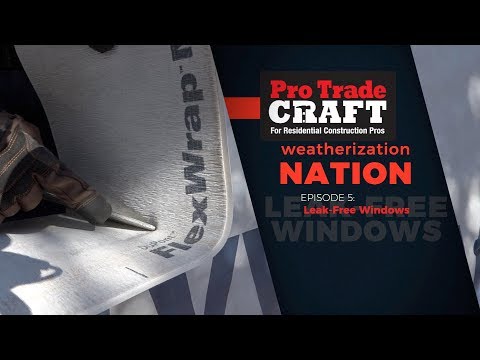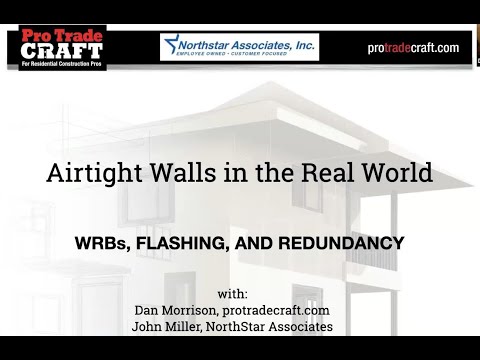This episode of Building Resilience illustrates framing walls— four types of walls, specifically, using continuous exterior insulation, Forcefield sheathing, and DensGlass for fire protection. The built-in WRB aspect of Forcefield quickens construction and simplifies the air barrier. DensGlass is a fire-stop requirement of local building codes.
Here's the show's transcript:
Last time on Building Resilience, we were whacking a wall with a stapler. Before that, we were covering a naked house with a self-adhered Hydrogap Weather Resistive barrier and flashing windows with Hydroflash LA, both from Benjamin Obdyke.
And the house looks sharp.
Because the adhesive is acrylic, it is easy to pull back and reposition. The crew sticks the top to the line and patiently smooths the rest. When the top section seems good, they peel off the lower release sheet and work the Hydrogap into place. Peel-and-stick WRB is great for flashing penetrations, and so is the blue hydroflash. Between the two, this wall isn’t ever going to leak.
This week. We’re discovering why no one likes digging holes in Minneapolis during the winter.
Ugh.
This week: Framing walls and sealing mudsills
We’re also gonna get after the framing portion of this stylish backyard shed, beginning with mudsills and wall framing. To locate the foundation bolts efficiently, Micheal measures locations and dictates the numbers to Joseph, who lays them out at the cut station. With the distance numbers reconciled, he specifies the distance from the edge of the plate. Joseph marks them and cuts the holes. And they plop the mudsills in place.
When they are all cut to fit, Joseph marks them, and they pull them up to deal with the capillary break and to pre-plug air leaks. That process begins with sweeping off the foundation so the Hydroflash LA will have something to stick to. Next, they have a unique solution to a unique condition.
We have a unique condition, so we had to come up with a unique solution. We are hanging the framing from the foundation, so we need to be able to do a few things. We need to protect the wood from the masonry, that’s the capillary break—both at the ends of the framing and the bottom plate.
We also want to think about termites. We don’t have them in the north yet, but they’re coming. So how can we incorporate a termite shield that will protect our wood framing? And then also, because we are putting two inches of insulation and sheathing on the outside, we want to make sure this extends far enough out to protect the underside of the foam and sheathing as well.
So we have a relatively simple shape that we’ve come up with; this face will protect the framing from the masonry; this face is going to protect our bottom plate from the masonry; and then it’s got this extension and hemmed drip edge for shed outside.
On top of the foundation, we gonna lay two beads of Hydrogap LA, the blue goo, its a liquid-applied flashing, and that will give us a nice air seal underneath that metal as well.
Michael Anschel, OA Design + Build + Architecture
It will also give a great air seal on top of the metal, where it will bed the mud sill into the metal flashing. Just make sure to locate the two beads within the footprint of the mud sill. And squirt the bolt holes, too. The sill snuggles into its little bed, and Steven bolts it down. While Michael stacks the floor, we’re going to visit the wall crew, who are standing walls, snapping lines, and cutting wood.
And nailing wall sheathing to the walls. This is Forcefield, as you can see on the face, and it is an OSB sheathing with a WRB laminated onto the face. This is a tall wall, but it is not the tallest wall. The far wall clocks in at 13 feet tall. There’s more complexity to the wall construction than height, too.
There are four types of walls in this tiny little shed-hut
The first wall type is a simple 2x6 wall, framed 16 inches on center, with a layer of ForceField sheathing on the outside. Just like what we saw Joseph nailing together. It is an uninsulated shed wall that does not face a property line. Forcefield sheets are nailed into the framing every 6 inches along the edges and 12 inches in the field. The sheets are gapped about ⅛ inch.
The second wall type is a variation of the first with 2x6 framing and a layer of Forcefield on the outside, but on this wall type, we’re going to sandwich two inches of styrofoam between the studs and the sheathing, and we’re making those insulated wall panels onsite.
We’re making out insulated wall panels here, we’ve got Dupont Zero GWP Styrofoam, which is 2 inches, for R-10; we’ve glued that using Huber’s subfloor adhesive to a 7/16 inch OSB sheet from Georgia Pacific with their ForceField facing.
The reason that we’re doing it this way is so that our nail base is on the outside, so we’re gonna go framing, styrofoam, Forcefiled sheathing, and pretty much every cladding out there can be installed into a 7/16 inch wall sheathing.
Wall type three is remarkably similar to wall type one 2x6 stud wall with Forcefield sheathing applied directly to the studs, but with an extra layer of DensGlass on the outside for fire protection. This is an uninsulated shed wall, but it faces the neighbor’s shed, so because its proximity to the property line, there must be a fire barrier.
Wall four is similarly similar to wall two: the styrofoam sandwich with an outer layer of Dens Glass, again for fire protection and neighbor proximity.
Now, there’s one caveat about making foam sandwiches like this. You really need to seal the inside stud cavities. We’re using spray foam, but you could use a sealant around the perimeter and then fill the cavity with other insulation. Just taping the face will not get you to airtightness due to the 3D airflow network created by building up these panels.
Tape the seams of Forcefield panels
All that gibberish doesn’t mean we won’t tape the seams. We’re doing that right now. The Forcefield tape is an acrylic tape formulated for the Forcefield facing, so you do not need to roll the tape or mash it into the substrate to make it stick for a long time. Georgia Pacific says that hand pressure is all that’s needed.
Window openings can be one of the leakiest parts of a wall because they are giant holes filled with glass. It is important to seal the edges of the hole against air leaks and to protect the framing against water leaks. We’re doing the water part right now with a flexible flashing membrane on the window sill. After the sill flashing is placed on the sill, it is formed around the corners.
Here’s a giant hole in the hole that will become a window. The gap where framing meets sheathing. The gap extends the perimeter of the window, so a 3-foot by 2-foot window has a 10-foot-long gap built into it. That gap needs to be sealed back to the framing with something. We’re going to use Forcefield tape, extending down to the sill flashing and folding into the opening.
Now, the face of the sheathing is sealed to the framing, with no leakage pathway on the sides, the top, or the bottom.
"One of the challenges with continuous exterior insulation, especially if it's thick, 2 inches or more, is what do you do at the corners?
So there's a couple ways to solve this. You can cut the foam back on one panel and run the other panel long. And then you have the OSB meeting OSB, and it's a little floaty, which is fine if you're doing corner boards that are of a decent width. But if you forget or if you're doing something like vinyl siding or, no corner trims, you're going to want a piece of solid blocking in there.
In this case, just a 2x4 ripped down to 2 inches, foam cut back out of this panel, and then attached to the framing. And you can see now we have a very solid nail base."
Corners with continuous insulation can be tricky
Let’s take a closer look at what he just said. We have a wall with Forcefield and foam on it. And we have another wall just like it sitting perpendicular. What happens when we make them a corner? There are 5-½ inches of uninsulated stud visible. To solve that, the insulated panel would have to be shifted over, which means you need to consider this when laying out the studs.
But that still doesn’t solve the issue Michael was talking about, the fact that foam is terrible at holding nails or screws from a corner board. For small corners, like those for vinyl, you need to provide some backing for the fasteners. Cutting the foam back and slipping in some solid lumber into that corner.
"Speaking of corners, we usually tape the corners, but sometimes, you know, there's too many nails on one side or the other, or the tape's not wide enough. One of the things that GP did that I think is pretty cool is that they've included a corner detail with their system.
So this is their Corner Seal product, and it comes out in a roll like this. You bend it, and it looks a lot like a drywall bead, the way you might mud up a corner, except that in this case, you just have to put a piece of tape on it, and now you've got a weathertight connection."
With the corner piece on the wall, Michael tapes the edges to the Forecfield facing. And he moves on to an inside corner to show that the strip works for them, too. You might have noticed that he did not extend the corner all the way to the top of the wall. I think that was so he could demonstrate how to overlap them if needed. Which is done like this. And then this.
And that’s about all there is to sealing up walls with an integrated WRB on the wall sheathing, like Forcefield. Next week, we’ll jump up on the roof and check out another sticky product: Vapor Dry Self-Adhered roofing membrane. It air seals and water seals a roof deck while allowing water vapor to dry out.
To make the roof assembly resilient to extreme weather events, they will fold the lower row down over the subfascia to completely air seal that leaky framing assembly. They do the same at the top of this shed roof, protecting the heck out of the roof edge from ice dams and sideways rain. Folding the VaporDry into the wall sheathing tightens the air barrier system without trapping moisture. And we’ll install a bunch of that stuff next time.
